


About Thailand
Thai Spa & Traditional Thai Massage
Thai Secret of Sensual Healing
| About Thailand | |||
| The kingdom of Thailand lies in the heart of Southeast Asia, making it a naturalgateway to Indochina, Myanmar and Southern China. Its shape and geography divide into four natural regions : the mountains and forests of the North; the vast rice fields of the Central Plains; the semi-arid farm lands of the Northeast plateau; and the tropical islands and long coastline of the peninsula South. | |||
 |
 |
 |
The country comprises 76 provinces that are further divided into districts, sub-districts and villages. Bangkok is the capital city and centre of political, commercial, industrial and cultural activities. It is also the seat of Thailand's revered Royal Family, with His Majesty the King recognised as |
Head of State, Head of the Armed Forces, Upholder of the Buddhist religion and Upholder of all religions. Thailand is a constitutional monarchy with His Majesty King Bhumibol Adulyadej, or King Rama IX, the ninth king of the Chakri Dynasty, the present king. The King has reigned for more than half a century, making him the longest reigning Thai monarch. Thailand embraces a rich diversity of cultures and traditions. With its proud history, tropical climate and renowned hospitality, the Kingdom is a never-ending source of fascination and pleasure for international visitors. |
|||
| Bangkok Bangkok was founded in 1782 by the first monarch of the present Chakri dynasty. It is now the country's spiritual, cultural, diplomatic, commercial and educational hub. It covers an area of more than 1,500 square kilometres, and it is home to approximatlely ten million people or more than 10% of the country's population. |
|||
| Over the last few decades, Thailand's capital city, Bangkok, has changed into a modern, exciting and sophisticated city. It offers to visitors not only the cosmopolitan amenities they would expect from other big cities, but also a unique treasure trove of cultural |  |
 |
 |
attractions. Thailand, in the heart of outheast Asia, was never colonised and thus kept its unique culture and heritage intact. Bangkok offers visitors the opportunity to experience fascinating glimpse of Thailand's gentle culture amidst the bustle of a great and dynamic metropolis. This great city has had astounding success in combining the ancient and modern world. For tourists, Bangkok has a feast of attractions to offer. The city is dotted with 400 glittering Buddhist temples of great beauty and fascination, agnificent palaces, classical dance extravaganzas, numerous shopping centres and traditional ways of life, especially along the "Venice of the East" timeless canals and the Chao Phraya River of the "River of Kings" winding through the city. It is worth taking a trip along its waters before exploring further into different canals to take a glimpse of old Bangkok. |
|||
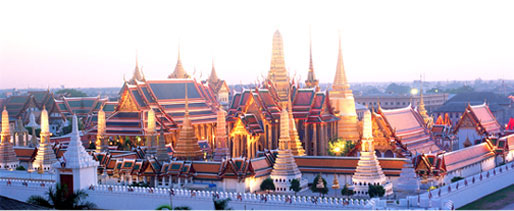 |
|||
| Chiang Mai Experiencing the merging of the past into the present in Chiang Mai where locals are proud of the city's 700-year history. Its rich traditional heritage and unique culture is a perfect foundation for the development of the city. Chiang Mai is one of the few places in Thailand where it is possible to find in the heart of the city centuries-old chedis and temples next to modern convenience stores and boutique hotels. The original city layout still exists as a neat square surrounded by a moat with vestiges of the fortified wall and its four main gates offering prime access to the old town. For years, tourists have mistaken Chiang Mai as the northern junction and the base from which they can explore other provinces. The phrase "a day in Chiang Mai is enough to see things around" was common. Today, tourists are surprised by the fact that there is always something new to discover Chiang Mai. Intriguing diversity among ethnic tribes coupled with breathtaking scenery makes Chiang Mai one of Asia's most attractive tourist destinations. Two weeks in Chiang Mai may not be long enough for serious travelers. The old city of Chiang Mai with its fascinating indigenous cultural identity such as diverse dialects, cuisine, architecture, traditional values, festivals, handicrafts and classical dances is a prime location in its own right. In addition, the presence of hill tribes and their wealth of unique cultures enhance Chiang Mai's distinctive diversity. |
|
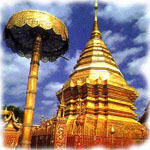 |
Chiang Mai is also blessed with pristine natural resources of mountains (dois), waterfalls, and other nature-based tourist attractions. At the same time, Chiang Mai residents are warm, gracious and congenial providing authentic hospitality making visits memorable and meaningful. Moreover, visitors from all walks of life can collect handicrafts of silk, silver and wood produced locally as timeless souvenirs. Chiang Mai is a place where both backpackers and luxury tourists can enjoy themselves to the fullest. The Past : Chiang Mai literally means new city and has retained the name despite having celebrated its 700th anniversary in 1996. King Meng Rai founded the city as the capital of the Lanna (A Million Rice Fields) Kingdom on Thursday, 12th April 1296 during the same period of time as the establishment of the Sukhothai Kingdom. King Meng Rai the Great conferred with his friends, King Ramkhamhaeng of Sukhothai and King Ngam Muang of Phayao before choosing the site where the capital of the Lanna Kingdom was to be founded. |
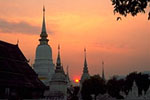 |
|
From then, Chiang Mai not only became the capital and cultural core of the Lanna Kingdom, it was also the centre of Buddhism in northern Thailand. King Meng Rai himself was very religious and founded many of the city's temples, which are still important today. At the height of its power, the Lanna Kingdom extended its territory far into Burma and Laos, and southwards to Kamphaeng Phet a province above Sukhothai. |
|
| Phuket Located approximately 862 kilometers south of Bangkok is Phuket, Thailand's largest island, which is often dubbed as the pearl of the Andaman, or the pearl of the south. Its natural resources- rocky peninsular, limestone cliffs, white powdery beaches, tranquil broad bays and tropical in-land forests contribute to making it the South's wealthiest, busiest, most visited and most popular island and province. Nestled in the tropical zone off the west coast of the southern part of Thailand in the Andaman Sea and the Indian Ocean, the province covers an area of approximately 543 square kilometers (excluding small islets). It is estimated that Phuket Province covers an area of approximately 590 square kilometers if its 39 other small islands are included. The islands total length, from north to south, is estimated at 48.7 kilometers and approximately 21.3 kilometers wide. |
|||
| Phuket borders on Phang-nga Province to the north. The other 3 sides are encircled by the Andaman Sea the place where many of the best diving sites are located. The island is connected to Phang-nga Province by Sarasin Bridge and Thep | 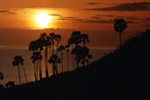 |
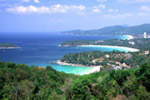 |
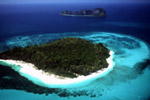 |
| Krasattri Bridge.
Staying on the island is easy, as there are only two seasons in a year - the
rainy season (May to October) and the hot season (November to April). The
low season of phuket is between September and October as they are the
wettest months. The best period for a visit, is from November to February,
when it is possible to see the clear blue sky, feel the fresh sea breeze and
marvel at the crystal clear water while lying on powdery, palm-fringed beaches.
Average temperatures ranges between 23 C and 33 C. Phuket's topology is exceptional with 70 percent of its area covered with mountains which stretch from north to south and the remaining 30 percent being plains located in the central and eastern parts of the island. The island does not have any major rivers except for a total of 9 brooks and creeks. Phuket is divided into 3 administrative counties namely Amphoe Muang, Amphoe Thalang and Amphoe Kathu. Phuket has a lot more to offer its visitors other than its natural heritage sea, sand, sky, beach, forest, and world renowned diving sites. Sino-Portuguese architecture casts its spell delighting travelers to the city, while Phuket-style hospitality has never failed to impress visitors from all walks of life. In addition, accommodations ranging from world-class resorts to tropical-style bungalows have warmly catered to the different needs of travelers. For seafood lovers, there is a lot more to sample than just Phuket’s famous lobster. Altogether, these characteristics have made Phuket a truly unique destination. |
|||
| Chonburti Chonburi, Bangkoks nearest seaside town, is located on the eastern coast of the Gulf of Thailand, only 80 kilometers from Bangkok. The area boasts abundant natural resources, which are highlighted by delightful beaches, local colors, traditions, delicacies and fresh seafood. This is a popular resort among Bangkokians who seek the nearest escape from hectic weekly schedules as Chon Buri has something for everyone. In addition, Chon Buri is the center of the Eastern Seaboard Development Project, with it industrial parks and fishing villages. |
|||
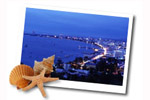 |
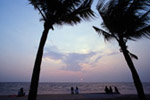 |
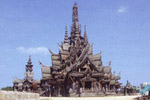 |
Pattaya A Travelers Paradise Pattaya is nestled along a picturesque bay on the East Coast of the Gulf of Thailand, roughly 170 kilometers southeast of Bangkok. From a fishing village in the 1960's, Pattaya has emerged |
as the favorite Southeast Asian vacation center. A fascinating escape where tourists, holiday makers and vacationers from around the world unfold an incomparable array of possibilities to unwind during an exotic holiday beach vacation. Unlike other beach resorts, where natural surroundings are used as magnets to attract tourists, Pattaya makes an all-out attempt to provide the best of everything. Here, everything means everything a tourist can imagine while on holiday: recreation, entertainment, sports, sightseeing and fun. To put it simply, Pattaya is a paradise for everyone, as it has a variety of attractions suitable for all types of visitors. This is the place where you can fill your day, from dusk to dawn, with endless activities, or you may choose to do nothing at all and relax. by Tourism Authority Of Thailand |
|||
